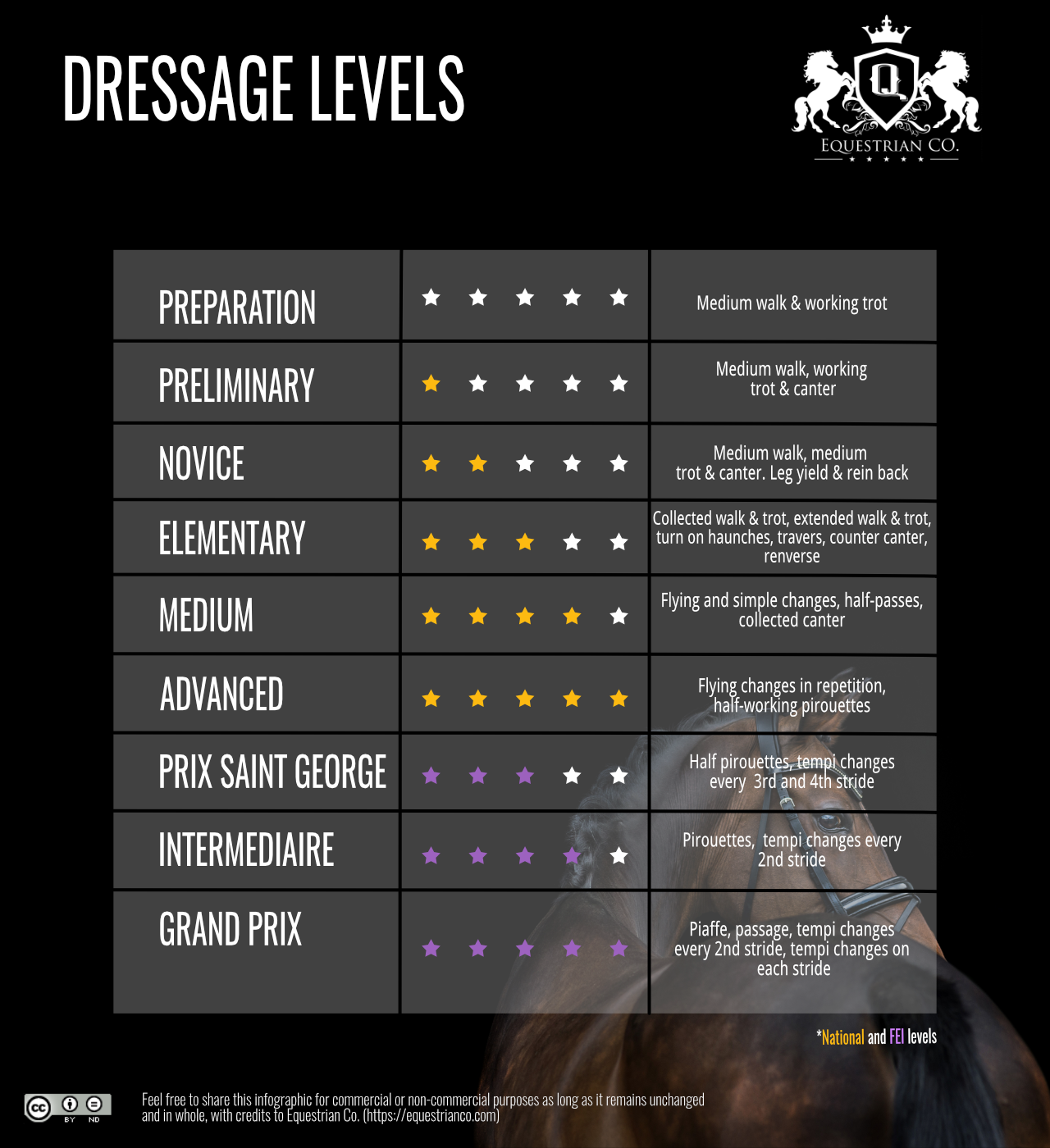
If you would like to embed this infographic on your website, simply use the code below.
Have you ever heard someone talking about their ‘elementary horse’ or how their youngster did at the ‘Intro A’ dressage test over the weekend and wondered what on earth that all meant? Dressage levels are a way to classify how advanced a horse and rider combination are, and provides an easy way to measure the expected level of schooling as well as the progression.
Dressage tests get progressively harder with each level, so each step up is like going up a grade in showjumping or eventing. In the UK, the progression is as follows:
Dressage Levels
- Introductory (or Intro)
- Preliminary (or Prelim, as it’s normally known)
- Novice
- Elementary
- Medium
- Advanced Medium
- Advanced
- Prix St Georges
- Intermediate I (often referred to simply as ‘Inter One’)
- Intermediate II (as above, normally called ‘Inter Two’)
- Grand Prix
Difficulty Progression
Within each level, there will be certain movements that the horse is asked to perform (at prelim, for example, it would be basic walk/trot/canter on straight lines and 20m circles but at Grand Prix, you have to show piaffe, passage, canter pirouettes and so on). These are fairly standard and will feature in all tests within that level. The movements asked will get harder as you progress up the levels to reflect the higher schooling of the horse.
Tests
Each level also has a variety of tests, so if you’re competing at Prelim then you don’t do the same test every single time. Of course, some of the tests will suit your horse more than others, even within the same level. You might find that one test has the lengthened trot on the right rein, whereas a different one has it on the left. Your Prelim 1 dressage test might have a transition at the judges’ box, where your horse always spooks, whereas the sequence of movements in the Prelim 2 dressage test could play more to your strengths. Generally, though, the lower numbered tests are considered the easier ones within that level, with the higher ones being the tests that people often do before they are considering moving up a level.
Movements
Introductory classes feature only walk and trot (no canter) and are the lowest level of competition. Grand Prix tests feature very advanced movements and are the levels of tests you see at big international competitions like the World Equestrian Games or World Championships. If you think of Valegro, you’re thinking of Grand Prix!
Here is a rough guide to what you might expect to see at each level if you were competing in the UK. Of course, each level could also include movements from the lower levels in addition to any new ones introduced:
- Introductory - walk and trot movements only
- Preliminary – walk, trot and canter, 20m circle
- Novice – serpentines, rein back, lengthened trot and canter, 15m circle
- Elementary - leg yields, simple changes and counter canter, stretch in canter
- Medium - Shoulder in and travers in trot, half pass in trot and canter, half walk pirouettes, collected walk/trot/canter, extended walk/trot/canter, canter entry to halt at X
- Advanced Medium – single flying change, 8m trot and canter circle/volte
- Advanced – canter half circle with quarters in, 4 and 5 time tempi changes
- Prix St Georges – half canter pirouette, 3 time tempi changes single change of leg after canter half pass (from counter canter to true canter)
- Intermediate I – 2 time tempi changes, full canter pirouette
- Intermediate II – 1 time tempi changes, flying changes after half pass, piaffe, passage
- Grand Prix



















